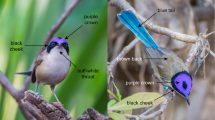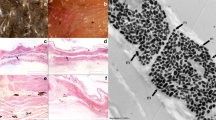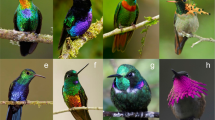Abstract
It has long been suggested that tropical species are generally more colourful than temperate species, but whether latitudinal gradients in organismal colourfulness exist remains controversial. Here we quantify global latitudinal trends in colourfulness (within-individual colour diversity) by collating and analysing a photographic dataset of whole-body plumage reflectance information for >4,500 species of passerine birds. We show that male and female birds of tropical passerine species are generally more colourful than their temperate counterparts, both on average and in the extreme. We also show that these geographic gradients can be explained in part by the effects of several latitude-related factors related to classic hypotheses for climatic and ecological determinants of organismal colourfulness. Taken together, our results reveal that species’ colourfulness peaks in the tropics for passerine birds, confirming the existence of a long-suspected yet hitherto elusive trend in the distribution of global biodiversity.
This is a preview of subscription content, access via your institution
Access options
Access Nature and 54 other Nature Portfolio journals
Get Nature+, our best-value online-access subscription
$29.99 / 30 days
cancel any time
Subscribe to this journal
Receive 12 digital issues and online access to articles
$119.00 per year
only $9.92 per issue
Buy this article
- Purchase on Springer Link
- Instant access to full article PDF
Prices may be subject to local taxes which are calculated during checkout




Similar content being viewed by others
Data availability
All analysis data are available in Supplementary Data 1. In addition, the phylogenetic trees were downloaded from http://www.birdtree.org, the geographic and ecological data were accessed via BirdLife International’s Data Zone (http://www.datazone.birdlife.org), and the global climate data were downloaded from WorldClim (https://worldclim.org/).
Code availability
The R code is available at https://github.com/christophercooney/Avian-colourfulness.
References
Darwin, C. R. On the Origin of Species, or the Preservation of Favoured Races in the Struggle for Life (John Murray, 1859).
Wallace, A. R. Natural Selection and Tropical Nature: Essays on Descriptive and Theoretical Biology 2nd edn (Macmillan, 1895).
Darwin, C. R. A Naturalist’s Voyage Round the World (John Murray, 1913).
Wallace, A. R. Colour in nature. Nature 19, 580–581 (1879).
Dalrymple, R. L. et al. Abiotic and biotic predictors of macroecological patterns in bird and butterfly coloration. Ecol. Monogr. 88, 204–224 (2018).
Adams, J. M., Kang, C. & June-Wells, M. Are tropical butterflies more colorful? Ecol. Res. 29, 685–691 (2014).
Bailey, S. F. Latitudinal gradients in colors and patterns of passerine birds. Condor 80, 372–381 (1978).
Wilson, M. F. & Von Neaumann, R. A. Why are neotropical birds more colourful than North American birds? Avicultural Mag. 78, 141–147 (1972).
Dalrymple, R. L. et al. Birds, butterflies and flowers in the tropics are not more colourful than those at higher latitudes. Glob. Ecol. Biogeogr. 24, 1424–1432 (2015).
Friedman, N. R. & Remeš, V. Ecogeographical gradients in plumage coloration among Australasian songbird clades. Glob. Ecol. Biogeogr. 26, 261–274 (2017).
Dale, J., Dey, C. J., Delhey, K., Kempenaers, B. & Valcu, M. The effects of life history and sexual selection on male and female plumage colouration. Nature 527, 367–370 (2015).
Dunn, P. O., Armenta, J. K. & Whittingham, L. A. Natural and sexual selection act on different axes of variation in avian plumage color. Sci. Adv. 1, e1400155 (2015).
Stoddard, M. C. & Prum, R. O. How colorful are birds? Evolution of the avian plumage color gamut. Behav. Ecol. 22, 1042–1052 (2011).
Renoult, J. P., Kelber, A. & Schaefer, H. M. Colour spaces in ecology and evolutionary biology. Biol. Rev. 92, 292–315 (2017).
Stoddard, M. C. & Prum, R. O. Evolution of avian plumage color in a tetrahedral color space: a phylogenetic analysis of New World buntings. Am. Nat. 171, 755–776 (2008).
Delhey, K. The colour of an avifauna: a quantitative analysis of the colour of Australian birds. Sci. Rep. 5, 18514 (2015).
Olson, D. M. et al. Terrestrial ecoregions of the world: a new map of life on Earth. Bioscience 51, 933–938 (2001).
Rabosky, D. L. et al. An inverse latitudinal gradient in speciation rate for marine fishes. Nature 559, 392–395 (2018).
Lynch, M. Methods for the analysis of comparative data in evolutionary biology. Evolution 45, 1065–1080 (1991).
Delhey, K. A review of Gloger’s rule, an ecogeographical rule of colour: definitions, interpretations and evidence. Biol. Rev. Camb. Phil. Soc. 94, 1294–1316 (2019).
Marchetti, K. Dark habitats and bright birds illustrate the role of the environment in species divergence. Nature 362, 149–152 (1993).
Endler, J. A. The color of light in forests and its implications. Ecol. Monogr. 63, 1–27 (1993).
Schemske, D. W. in Speciation and Patterns of Diversity Vol. 12 (eds Butlin, R. et al.) 219–239 (Cambridge Univ. Press, 2009).
Schemske, D. W., Mittelbach, G. G., Cornell, H. V., Sobel, J. M. & Roy, K. Is there a latitudinal gradient in the importance of biotic interactions? Annu. Rev. Ecol. Evol. Syst. 40, 245–269 (2009).
MacArthur, R. H. Patterns of communities in the tropics. Biol. J. Linn. Soc. 1, 19–30 (1969).
Hadfield, J. D. & Nakagawa, S. General quantitative genetic methods for comparative biology: phylogenies, taxonomies and multi-trait models for continuous and categorical characters. J. Evol. Biol. 23, 494–508 (2010).
Cooney, C. R. et al. Sexual selection predicts the rate and direction of colour divergence in a large avian radiation. Nat. Commun. 10, 1773 (2019).
Cooney, C. R., MacGregor, H. E. A., Seddon, N. & Tobias, J. A. Multi-modal signal evolution in birds: re-assessing a standard proxy for sexual selection. Proc. R. Soc. B 285, 20181557 (2018).
van der Bijl, W. et al. Butterfly dichromatism primarily evolved via Darwin’s, not Wallace’s, model. Evol. Lett. 4, 545–555 (2020).
Darwin, C. R. The Descent of Man, and Selection in Relation to Sex (John Murray, 1871).
Tobias, J. A., Montgomerie, R. & Lyon, B. E. The evolution of female ornaments and weaponry: social selection, sexual selection and ecological competition. Phil. Trans. R. Soc. B 367, 2274–2293 (2012).
Galván, I., Negro, J. J., Rodríguez, A. & Carrascal, L. M. On showy dwarfs and sober giants: body size as a constraint for the evolution of bird plumage colouration. Acta Ornithol. 48, 65–80 (2013).
Kiltie, R. A. Scaling of visual acuity with body size in mammals and birds. Funct. Ecol. 14, 226–234 (2000).
Zahavi, A. & Zahavi, A. The Handicap Principle (Oxford Univ. Press, 1997).
Badyaev, A. V. & Hill, G. E. Avian sexual dichromatism in relation to phylogeny and ecology. Annu. Rev. Ecol. Evol. Syst. 34, 27–49 (2003).
Simpson, R. K., Johnson, M. A. & Murphy, T. G. Migration and the evolution of sexual dichromatism: evolutionary loss of female coloration with migration among wood-warblers. Proc. R. Soc. B 282, 20150375 (2015).
Helferich, G. Humboldt’s Cosmos (Tantor eBooks, 2011).
Jetz, W., Thomas, G. H., Joy, J. B., Hartmann, K. & Mooers, A. O. The global diversity of birds in space and time. Nature 491, 444–448 (2012).
He, Y. et al. Segmenting biological specimens from photos to understand the evolution of UV plumage in passerine birds. Preprint at bioRxiv https://doi.org/10.1101/2021.07.22.453339 (2021).
Chen, L. C., Zhu, Y., Papandreou, G., Schroff, F. & Adam, H. Encoder–decoder with atrous separable convolution for semantic image segmentation. Preprint at arXiv https://doi.org/10.48550/arXiv.1802.02611 (2018).
Hussein, B. R., Malik, O. A., Ong, W.-H. & Slik, J. W. F. in Computational Science and Technology Lecture Notes in Electrical Engineering (eds Alfred, R. et al.) 321–330 (Springer Singapore, 2020).
Troscianko, J. & Stevens, M. Image calibration and analysis toolbox—a free software suite for objectively measuring reflectance, colour and pattern. Methods Ecol. Evol. 6, 1320–1331 (2015).
Hijmans, R. J. raster: Geographic Data Analysis and Modeling. R package version 3.5-15 https://CRAN.R-project.org/package=raster (2022).
Maia, R., Gruson, H., Endler, J. A., White, T. E. & O’Hara, R. B. pavo 2: new tools for the spectral and spatial analysis of colour in R. Methods Ecol. Evol. 10, 1097–1107 (2019).
Stoddard, M. C. et al. Wild hummingbirds discriminate nonspectral colors. Proc. Natl Acad. Sci. USA 117, 15112–15122 (2020).
Gomez, D. & Théry, M. Simultaneous crypsis and conspicuousness in color patterns: comparative analysis of a neotropical rainforest bird community. Am. Nat. 169, S42–S61 (2007).
Blonder, B. Do hypervolumes have holes? Am. Nat. 187, E93–E105 (2016).
Schliep, K. P. phangorn: phylogenetic analysis in R. Bioinformatics 27, 592–593 (2011).
Fick, S. E. & Hijmans, R. J. WorldClim 2: new 1-km spatial resolution climate surfaces for global land areas. Int. J. Climatol. 37, 4302–4315 (2017).
Beckmann, M. et al. glUV: a global UV-B radiation data set for macroecological studies. Methods Ecol. Evol. 5, 372–383 (2014).
Running, S. W. et al. A continuous satellite-derived measure of global terrestrial primary production. Bioscience 54, 547–560 (2004).
Tobias, J. A. & Pigot, A. L. Integrating behaviour and ecology into global biodiversity conservation strategies. Phil. Trans. R. Soc. B 374, 20190012 (2019).
Dunn, P. O., Whittingham, L. A. & Pitcher, T. E. Mating systems, sperm competition, and the evolution of sexual dimorphism in birds. Evolution 55, 161–175 (2001).
Bivand, R. S. & Wong, D. W. S. Comparing implementations of global and local indicators of spatial association. TEST 27, 716–748 (2018).
Hawkins, B. A. et al. Structural bias in aggregated species-level variables driven by repeated species co-occurrences: a pervasive problem in community and assemblage data. J. Biogeogr. 44, 1199–1211 (2017).
Hadfield, J. D. MCMC methods for multi-response generalised linear mixed models: the MCMCglmm R package. J. Stat. Softw. 33, 1–22 (2010).
Healy, K. et al. Ecology and mode-of-life explain lifespan variation in birds and mammals. Proc. R. Soc. B 281, 20140298 (2014).
R Core Team R: A Language and Environment for Statistical Computing (R Foundation for Statistical Computing, 2021); https://www.R-project.org/
Acknowledgements
We thank M. Adams, H. van Grouw, R. Prys-Jones and A. Bond from the Bird Group at the Natural History Museum at Tring for providing access to and expertise in the collection, N. Brett for assistance with data collection, and F. Babarović, J. Kennedy, L. Rombault and A. Slavenko for helpful discussion and feedback. This work was funded by a Leverhulme Early Career Fellowship (ECF-2018-101) and a Natural Environment Research Council Independent Research Fellowship (NE/T01105X/1) to C.R.C., a Leverhulme Centre for Advanced Biological Modelling PhD studentship to Y.H., a Royal Society Wolfson Merit Award (WM170050, APEX APX\R1\191045) and a National Research, Development and Innovation Office of Hungary grant (ÉLVONAL KKP-126949, K-116310) to T.S., and a European Research Council grant (615709, Project ‘ToLERates’) and a Royal Society University Research Fellowship (UF120016, URF\R\180006) to G.H.T.
Author information
Authors and Affiliations
Contributions
C.R.C. and G.H.T. designed the research. C.R.C., Z.K.V., L.O.N., C.J.A.M., M.D.J., A.L. and T.S. collected the data. C.R.C. and Y.H. conducted the analyses. C.R.C. wrote the manuscript, with input from all authors.
Corresponding author
Ethics declarations
Competing interests
The authors declare no competing interests.
Peer review
Peer review information
Nature Ecology & Evolution thanks José Alexandre Diniz Filho, James Dale and the other, anonymous, reviewer(s) for their contribution to the peer review of this work.
Additional information
Publisher’s note Springer Nature remains neutral with regard to jurisdictional claims in published maps and institutional affiliations.
Extended data
Extended Data Fig. 1 The distribution of sampled species and illustrations of the colouration data workflow and colour diversity metrics used in this study.
a, The proportion of passerine species sampled per grid cell. Grid cell size is 50 × 50 km (Behrman projection) and only cells containing at least 5 passerine species are plotted. b, The phylogenetic distribution of sampled species (blue, n = 4,527) relative to the whole passerine radiation (n = 5,966). c, An example showing the workflow used to extract whole-body reflectance data from specimen images, as applied to lateral (side) view images. An analogous workflow is applied to the other two views of the specimen (dorsal and ventral). The resulting sets of measurements for each view are then combined into a final dataset of 1,500 measurements for each specimen, capturing whole-body plumage colouration. d, The relationship between specimen-level scores of colour loci and colour volume based on a ultraviolet-sensitive (UVS) visual system.
Extended Data Fig. 2 Latitudinal gradients in male and female colourfulness in passerine birds using colour volume.
a, Mean colour volume scores for grid cell assemblages, separately for males (top) and females (bottom). b, c, Distributions of mean species’ colour volume scores for grid cells (b) and ecoregions (c) with respect to latitude, separately for males (top) and females (bottom). Grid cell size is 50 × 50 km for all panels (Behrman projection) and only cells containing at least 5 sampled species are plotted. Colour volumes are based on an ultraviolet- sensitive (UVS) visual system. Note: colour volume values are multiplied by 1000.
Extended Data Fig. 3 Geographic distributions of male and female colourfulness in passerine birds using different datasets.
Grid cell size is 50 × 50 km for all panels (Behrman projection) and only cells containing at least 5 sampled species are plotted. UVS, ultraviolet sensitive; VS, violet sensitive. Note: colour volume values are multiplied by 1000.
Extended Data Fig. 4 Geographic distribution of the proportion of species in passerine assemblages in the top colour diversity quartile using different datasets.
Grid cell size is 50 × 50 km for all panels (Behrman projection) and only cells containing at least 5 sampled species are plotted. UVS, ultraviolet sensitive; VS, violet sensitive.
Supplementary information
Supplementary Information
Supplementary Tables 1–7.
Supplementary Data 1
Supplementary dataset.
Rights and permissions
About this article
Cite this article
Cooney, C.R., He, Y., Varley, Z.K. et al. Latitudinal gradients in avian colourfulness. Nat Ecol Evol 6, 622–629 (2022). https://doi.org/10.1038/s41559-022-01714-1
Received:
Accepted:
Published:
Issue Date:
DOI: https://doi.org/10.1038/s41559-022-01714-1
This article is cited by
-
Plumage and eggshell colouration covary with the level of sex-specific parental contributions to nest building in birds
The Science of Nature (2024)
-
Alfred Russel Wallace’s legacy: an interdisciplinary conception of evolution in space and time
npj Biodiversity (2023)
-
A colourful tropical world
Nature Ecology & Evolution (2022)



